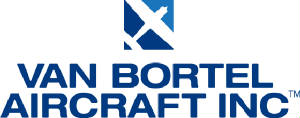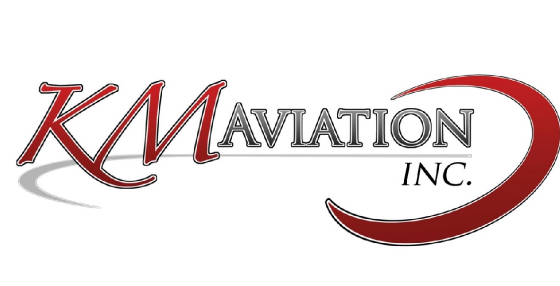|
|
With 2200 + hours on the old 235 hp engine, it was time for a change .....
December 2012: It started with a trickle ... not of oil or grease, but
of incoming parts. First came a small package of nuts and bold, then cables, a spinner, paperwork, a brand new 3  blade MT prop, more paperwork, Tempest fine wore spark plugs and a vacuum pump and the engine. Ahhh, the engine: a brand
spanking new, shiny blade MT prop, more paperwork, Tempest fine wore spark plugs and a vacuum pump and the engine. Ahhh, the engine: a brand
spanking new, shiny 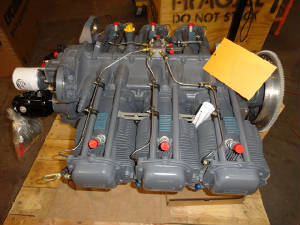 Lycoming IO-540 260hp. This has been a project in the making for more than 3 years. When I saw that I was flying over 300
hours per year, I realized that TBO was not far off. We contacted Alamo Aerospace to chat about their 260 hp upgrade. It was
not that we needed more horse power or speed - we have plently of that, sporting a race handicap of 160 kts - but we needed
safety. Jack Sledge of Alamo Aerospace is a speed guy. He was marketing this to us on speed and climb performance. Well, OK,
the climb rate is impressive but I was after the dual mags - NOT the single drive mag that was on the old engine. I was after
fuel injection - ditching the old catburator and poor altitude performance. Lycoming IO-540 260hp. This has been a project in the making for more than 3 years. When I saw that I was flying over 300
hours per year, I realized that TBO was not far off. We contacted Alamo Aerospace to chat about their 260 hp upgrade. It was
not that we needed more horse power or speed - we have plently of that, sporting a race handicap of 160 kts - but we needed
safety. Jack Sledge of Alamo Aerospace is a speed guy. He was marketing this to us on speed and climb performance. Well, OK,
the climb rate is impressive but I was after the dual mags - NOT the single drive mag that was on the old engine. I was after
fuel injection - ditching the old catburator and poor altitude performance. I was a bit concerned, however, about that McCauley
3 blade that was part of the Alamo Aerospace STC. The engine adds 25 pound to the nose of 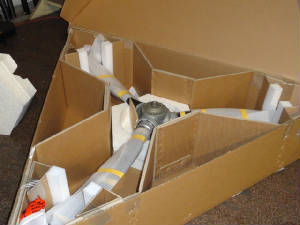 an already nose heavy airplane. But the 3 blade McCauley put another 25 pounds out there, throwing us out
of forward CG without the addition of a counterweight in the most aft station. I think not. The addition of 50 pounds was
bad enough but the extra 4 pounds of useless ballast was more than I could stomach. The hunt was on for a suitable alternative.
Hello MT. an already nose heavy airplane. But the 3 blade McCauley put another 25 pounds out there, throwing us out
of forward CG without the addition of a counterweight in the most aft station. I think not. The addition of 50 pounds was
bad enough but the extra 4 pounds of useless ballast was more than I could stomach. The hunt was on for a suitable alternative.
Hello MT.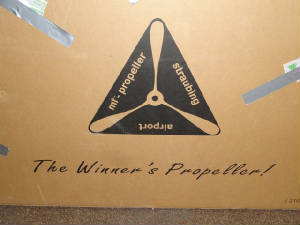 We had tried working with Hartzel and McCauley but the process for hte addition of the prop to the STC was not economically
feasible. MT, however, said they could get it done on a field approval basis for a reasonable fee. Done! This 3 bladed MT
is actually less weight than the current 2 blade McCauley that I am flying now. S-W-E-E-T! We had tried working with Hartzel and McCauley but the process for hte addition of the prop to the STC was not economically
feasible. MT, however, said they could get it done on a field approval basis for a reasonable fee. Done! This 3 bladed MT
is actually less weight than the current 2 blade McCauley that I am flying now. S-W-E-E-T!So now, the end of December, Vern is working at a feverish pitch to get the engine removed and shipped back to Lycoming so he can get the new engine hung for the New Year. This is a major operation but I am confident all will go smoothly. February 2013: With Wild Mama gutless,
Vern suddenly got busy with "paying jobs" so Wild Mama had to take a back seat for a bit. Little by little
progress was being made. The
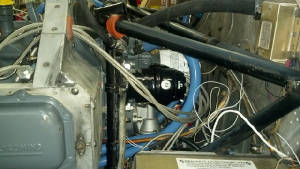 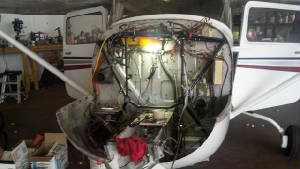 engine has been removed and now replaced; the prop is on; we have our nice blue Huber hoses installed and Tad is starting
to work on the wiring part of the program. There are any new sensors and wires to run for the MVP50 - the part of the job
that will actually take the longest. Tempest has delivered a host of items including the new spark plugs and the vacuum pump
that conveniently failed on Wild Mama's last trip out in October to the 99s meeting in Oklahoma City. Now, as I get
ready to head back to Oklahoma City for the next International 99s BOD meeting, I was hoping for a fresh new ride but .....
I am relegated to "Mile Mama" my 2005 Ford engine has been removed and now replaced; the prop is on; we have our nice blue Huber hoses installed and Tad is starting
to work on the wiring part of the program. There are any new sensors and wires to run for the MVP50 - the part of the job
that will actually take the longest. Tempest has delivered a host of items including the new spark plugs and the vacuum pump
that conveniently failed on Wild Mama's last trip out in October to the 99s meeting in Oklahoma City. Now, as I get
ready to head back to Oklahoma City for the next International 99s BOD meeting, I was hoping for a fresh new ride but .....
I am relegated to "Mile Mama" my 2005 Ford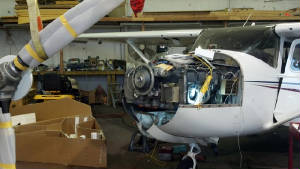 Freestyle. Freestyle. 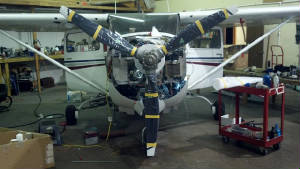 As I am off on this journey that will take me to OKC, Fayetteville to visit the 2013 ARC race terminus, then on to Nashville
for the 2013 WAI Convention, Vern will remain behind to make steady progress. After the installation, there is still engine
break-in; flight learning curve; equipment learning curve; flight testing and race testing before we head off for the 2013
Air Race Classic. Time is getting short ... will Wild Mama be ready???? As I am off on this journey that will take me to OKC, Fayetteville to visit the 2013 ARC race terminus, then on to Nashville
for the 2013 WAI Convention, Vern will remain behind to make steady progress. After the installation, there is still engine
break-in; flight learning curve; equipment learning curve; flight testing and race testing before we head off for the 2013
Air Race Classic. Time is getting short ... will Wild Mama be ready????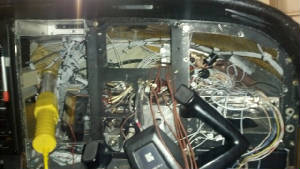 March 23, 2013: After a very long journey in "Mile Mama" - that would be just short of 50 driving hours - I am ready for Wild Mama to return to service. Vern has still been delayed with moving to a new house and all the things that go with that. But with the move finally over, he can concentrate on getting Wild Mama finished. The pressure is on now - the next adventure is to the 99s SE Section meeting in Mobile. I WILL be flying Wild Mama to the meeting. Ellen and I need some serious seat time for aircraft performance testing and learning how to fly her all over again. The new engine monitor, fuel injection and new performance characteristics need to be well explored and learned before we leave for the race on June 1st. It is officially a nail biter now. March 30th: When things started to move they
moved like greased lightening. Vern has been solid on Wild Mamafor the past week and once the wires were run, tied
back and With
the path clear, Vern pulled her outside for a ground test. This is the first time the engine is going to run so it is a very
important day in her life. we tied the tail as tightly as possible to prevent her escape; set the brakes and spun the starter.
She started like a charm and sounded like the lean, mean racing machine that she is. Vern ran her for over half hour testing
all sorts of functions while I played with with MVP 50 to see how it works and what it monitors. There will most certainly
be a learning Once the start up was complete, Vern declared "success" even though there are some minor adjustment that must be made yet. Then he competes the remainder of the annual inspection even though there is not much left to do as she had been apart from stem to stern. We are hoping for a flight test late Monday afternoon. Fingers crossed for good flying weather Monday. Wild Mama is Alive - the first start-up. April 2013: It has been a hectic last couple of weeks. We got Wild Mama in the air April 3rd, just in time for my April 4th run to Mobile .... which did not happen due to my 3 strike rule: new engine, questionable weather and "gotta be there". I drove to Mobile with Ellen in "Mile Mama" once again. Upon my return, however, was Sun-n-Fun and Wild Mama WAS GOING! I was having this "sinking" issue. It seems that prop flattened out too much when at the full RPM position and in the pattern, I was dropping like a rock without an extreme amount of power. But I adjusted temporarily to make a few test flights so we could make the squawk list and fix all of the bugs at once. Wild Mama was a different bird: she looked like a duck, but did not waddle nor quack like a duck. But she was the same duck. She is smooth, oh, so smooth. That old shaky 235 hp and 2 blade prop no more than a distant memory. She is full of pep and vinegar and climbs like she has never climbed before. And, yes, she is faster. My first order of business was get accustomed to the glass engine monitor. It looks cool but for one who has not looked at an all digital presentation, it takes a few moments to adjust. After the first 30 minute flight, it was old hat. The MVP50 is nice. It has many screens for leaning, engine performance, fuel management and just plain flying. It is amazing how much information can be stuffed into a small box. But now it is Monday morning and I am off to Sun-n-Fun for the week. Wild Mamamade
a flawless trip with an "arrival" on the orange dot. (Still must fix that sink rate.) She was a Vern's first order of business was the pitch stops on the prop to stop it from flattening so much. He made those adjustments, worked on the baffling to adjust the cylinder head temperatures and adjusted the RMPs which were hovering at 2720. We made the test flight with calm winds on a warm morning with great success. The sinking was gone, temperatures were down and the RPMs remain steady at 2680 with an occasional flicker to 2690 and 2700. With 6 hours now on the engine, it is my turn to work on the break in. She is not using oil but a long trip is in order. Oh, darn, I have to go fly. I so love when that happens. Welcome back Wild Mama!!!! April 24th: ... and a good long run it was, indeed. Now with 10 hours on the engine and a host of hour long flights under m belt plus a few practice approaches, I am ready to take Wild Mama off for a good long run. Vrn fixed the pitch stops, much to my delight to stop that sinking on final, and we have everything else in order to venture far from home. The weather
in LaBelle was perfect for a VFR launch. I filed IFR because of some reported clouds and the possibility of having to shoot
the approach coming in to Rowan County, NC for a first fuel stop. Just after 0800 I was in the air climbing out at a respectable
145 kts ground speed. Oh, goodie, I will have a tail wind. Almost immediate I got really busy. The CO2 sensor started alerting
again, ATC was trying to give me clearance instructions and vectoring me for traffic and I was still trying to monitor everything
and fly. I had The flight remained smooth, the CO2 sensor stopped pinging and I accepted my last vector before heading out over the Atlantic. I was left good and confused by a clearance that said "After leaving KIZER, head north on V267 and we will get you to STARY," but with a little clarification after "heading north" I managed to see the point of the exercise. Now the radio got quiet and I sat with the hum of the motor watching instrument panel and looking out across the hazy sky. My speed was slowly increasing as I neared NC - a comforting site as I watched my now digital fuel gauges tick off the fuel being used. While I proably had the same amount, there is something about looking at actual numbers that was a bit more disconcerting. As the fuel number got lower, I was getting a bit uneasy. I checked in the weather in to Rowan County to see 1300 overcast. The METAR was 30 minutes old but I decided to request the ILS 20 approach even though the skies appeared to be clearing. I was being vectored in for the approach when the alarms started again. The CO alerted and I silenced it for 10 minutes .... but it alerted again. Now what was wrong? Apparently, in the left turn, the fuel sensor dipped into the alert zone. Each subsequent turn produced the same result so I had a barrage of red and yellow alerts while I am trying to hear ATC. Time to kill the voice alerts all together. I complete an uneventful approach and refueled in Rowan County before blasting off for the last part of the trip. I had been flight planning and filing for 145kt
airspeed but it became readily apparent that that was not enough. I refiled for 155 for this last leg and climbed out to 5,000'.
The wind and clouds had both picked up and I found myself on a rather bumby ride. As I was getting further climb out instructions,
I was assigned 6,000' - it was not the right altitude but I was out of the bucking bronco zone. Not long after I made 6,000',
I was assigned 7,000' and made my ast climb to settle in at an impressive 45 kt tail wind. I was zooming Now with 30% more speed than I am accustomed to having I am geting really busy in the cockpit. Forget lunch. With radio changes, route changes, altitude changes and descending through the moutains on a windy day I was strapped in and ready for the ride of my life. In a short 1:45 I had made the last part of the trip that would usually take me just over 2:30. The winds in Westminster were reported as 10 kts but I can say that is the hardest and bumpiest 10 kts I have felt. After landing and fighting to stay on the runway I opened the door where the wind caught my hat and blew it down the tarmac. Sister Michelle, who came to greet me, took off running. It was a chore getting the cover on and getting Wild Mama buttoned up but we managed and I was ready to just sit still for a while. I got some good readings during the flight but must work on the fuel CO2 and cylinder 1 temperature. I think I can get them under control for the flight home. I am hoping for another tail wind but forecasts are not in my favor. A large storm was marching its was across the central portion of the US. There were reports of tornados
and severe damaging weather and it was headed for the east coast. It was I landed at KCPC, Columbus County, NC behind an RV who was done fueling as I was motioned to
the fuel pumps. The FBO fellow and I struck up and conversation and I introduced myself only to hear "I know you"
from the RV driver. It was Karen Candiani's husband, Don headed north from Charlotte County. This is also the stop Mary Wunder
used on the infamous "Petie Express" trip. Small world. I made a hasty stop and pressed on as they storm was
growing bigger and nearer. I had to get past Charleston to be home free. The ceiling lowered and I was unable to maintain
2,000' meaning I had to go through The majority of the trip found the temperatures hovering at 400 with the cowl flaps slightly cracked. While this was better than the trip up, it was still not as good as I wanted since I was only flying at 75% power. More work for Vern. I landed back at LaBelle no worse for the wear but headed straight for the maintenance hangar. I hope she is ready for the race.
|
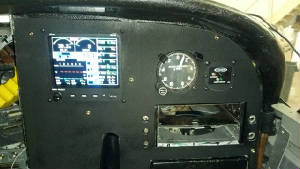 probes properly inserted into their cubbies, the panel went back together in a flash. Vern made the new panel cover as the
old one was woefully inadequate. It turned out really nice. Then piece by piece, the avionics went in, the new MVP50 - which
was the real culprit to the delay of job completion - went in and was hooked up; the remainder of the center stack was installed
then a path was cleared for her departure from the maintenance hangar. Wild Mama had been in the back of the hangar
so long, she homesteaded herself a little piece. Now she has to vacate that spot - sorry, Rick, you are there now - so she
could go out in the brilliant Florida sunshine and strut her stuff.
probes properly inserted into their cubbies, the panel went back together in a flash. Vern made the new panel cover as the
old one was woefully inadequate. It turned out really nice. Then piece by piece, the avionics went in, the new MVP50 - which
was the real culprit to the delay of job completion - went in and was hooked up; the remainder of the center stack was installed
then a path was cleared for her departure from the maintenance hangar. Wild Mama had been in the back of the hangar
so long, she homesteaded herself a little piece. Now she has to vacate that spot - sorry, Rick, you are there now - so she
could go out in the brilliant Florida sunshine and strut her stuff.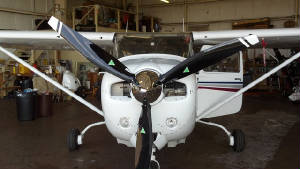 curve: not only with the MVP 50 but with the infamous "hot start" that I never had to do with a carbonated engine.
curve: not only with the MVP 50 but with the infamous "hot start" that I never had to do with a carbonated engine.
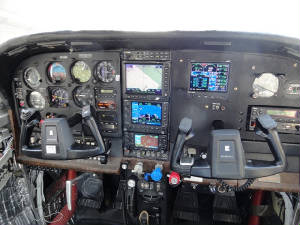
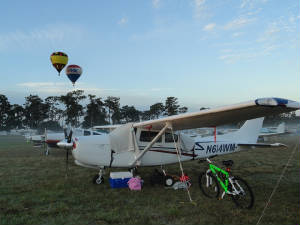 real attention getter as the typical 182 lover sensed something different about her and HAD to come for a visit. After
a fun and sun filled week we headed back to LaBelle, climbing on top of the fog layer than quickly enveloped the inland areas.
I filed for a pop up clearance and shot the GPS14 approach into LaBelle. With all systems working, it was time to work on
the squawk list.
real attention getter as the typical 182 lover sensed something different about her and HAD to come for a visit. After
a fun and sun filled week we headed back to LaBelle, climbing on top of the fog layer than quickly enveloped the inland areas.
I filed for a pop up clearance and shot the GPS14 approach into LaBelle. With all systems working, it was time to work on
the squawk list.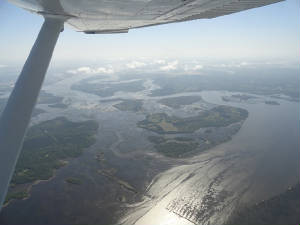 forgotten how busy single pilot IFR can be. I got a level off at 4,000' and started leaning the mixture to see what my range
was going to be. I have been most concerned about the range and keeping the power srtting up to 75% because she will be eating
more fuel than before and I had a 4 hour trip ahead of me. We settled in at about 14.7 gph, giving me plenty of reserve for
the trip.
forgotten how busy single pilot IFR can be. I got a level off at 4,000' and started leaning the mixture to see what my range
was going to be. I have been most concerned about the range and keeping the power srtting up to 75% because she will be eating
more fuel than before and I had a 4 hour trip ahead of me. We settled in at about 14.7 gph, giving me plenty of reserve for
the trip.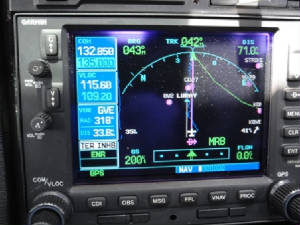 along averaging over 195 kts over the groung. Speeds in the low 200kt zone were common. I am loving life.
along averaging over 195 kts over the groung. Speeds in the low 200kt zone were common. I am loving life.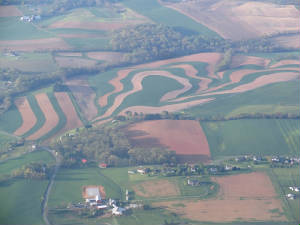 Saturday and I had really hoped to remain a few more days but decided to prepare for an early Sunday morning departure. As
suspected, the winds were not going to be kind and the higher I climbed, the worse the forecast. I hoped I could remain low.
By 0700 Sunday morning I was in the air with the dreaded headwinds. I remained at 2800' to get through the Washington DC area
airspace then dropped down to 2,500' as I headed more southerly. All was looking good through my planned fuel stop.
Saturday and I had really hoped to remain a few more days but decided to prepare for an early Sunday morning departure. As
suspected, the winds were not going to be kind and the higher I climbed, the worse the forecast. I hoped I could remain low.
By 0700 Sunday morning I was in the air with the dreaded headwinds. I remained at 2800' to get through the Washington DC area
airspace then dropped down to 2,500' as I headed more southerly. All was looking good through my planned fuel stop. 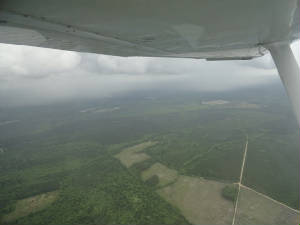 Charleston airspace. I tried to hail them but no answer so I plotted myself a course precariously perched on the rim of the
Class C on one side and uncomfortably close to the nasty rain storm on the other. I made it through with only a minor bug
washing.
Charleston airspace. I tried to hail them but no answer so I plotted myself a course precariously perched on the rim of the
Class C on one side and uncomfortably close to the nasty rain storm on the other. I made it through with only a minor bug
washing.
